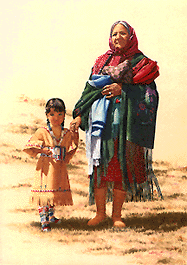



"The Giveaway"
 "Home From the Trading Post"
"Home From the Trading Post"
Many Native Americans now believe the Dream Catcher is the symbol of love and protection. The exact legend of the Dream Catcher will never be known, because the beliefs vary from one tribe to another. The Dream Catcher is believed to offer protection from nightmares and evil spirits in the night. The web catches the bad dreams where the morning dew evaporates them. The good dreams find their way through the center of the Dreamcatcher and enter the life of the dreamer.
"Dreamcatcher"
"Shadow of Someone Else"
The profile of this Nez Peirce woman shows her face painted in the traditional manner, using river bank white clay. She wears a dress of doe skin with the animal's tail tied around the neck of the dress.

 "Ghost Story"
"Ghost Story"
 The personal adornments of this "Holy Man of The Blackfoot", a once brave warrior and skilled hunter, include references to many coup...victories won, lances taken, and rifles captured.
The personal adornments of this "Holy Man of The Blackfoot", a once brave warrior and skilled hunter, include references to many coup...victories won, lances taken, and rifles captured.
 "War Council on the Plains"
"War Council on the Plains"

A SHORT HISTORY LESSON
For centuries, the Indian tribes of North America thrived in relative isolation to the white man. Their undisturbed civilizations rapidly changed, however, after the Lewis and Clark expedition of 1804 sparked official United States government interest in the West. Thus began treaty negotiations with every tribal nation.
In 1821, the United States government engaged Charles Bird King to paint portraits of those Indians sent to Washington on official business. In 1865, the originals, by then in the Smithsonian Institution, were destroyed by fire. These two paintings are King's own copies, given to the White House in 1962.
 Sharitarish, or "Wicked Chief" of the Pawnee Tribe.
Sharitarish, or "Wicked Chief" of the Pawnee Tribe.
 Hayne Hudjihini, or "Eagle of Delight", of the Oto Tribe. She contracted measles during her visit and died shortly after she returned home.
Hayne Hudjihini, or "Eagle of Delight", of the Oto Tribe. She contracted measles during her visit and died shortly after she returned home.
The federal government, fearing that the powerful and militant tribes of the Great Plains would oppose westward expansion, invited a number of Native American leaders to visit the nation's most important cities and forts and to meet their "Great Father" the President. Government officials hoped to overawe these Indians with an impressive show of military strength,luxurious gifts, and elaborate ceremony.
When the Native Americans arrived in Washington, merchants fitted them out in military finery for an audience with President James Monroe. They were formally received by the President in the Red Room on February 4, 1822. With the help of interpreters, he thanked them for coming, spoke of white man's strength and the blessing of peace, and offered to send missionaries to instruct them in Christianity and agriculture.
The chiefs, impressed but feeling ill at ease in their new clothes, gravely replied that they admired the things they had seen but preferred their own life of trapping bear and hunting buffalo. Sharitarish, their leader, added: "...we have plenty of land, if you will keep your people off it."
Each speaker laid a gift at the President's feet: moccasins, feathered headdresses, buffalo robes, and peace pipes. Before the party moved to the Blue Room for cake and wine, Sharitarish expressed the hope that Monroe would order the presents kept "in some conspicuous part of your lodge, so that when we are gone,...if our children should visit this place, as we do now, they may see and recognize with pleasure the deposits of their fathers, and reflect on times that are past." The gifts were unfortunately lost long ago, and efforts to avoid fighting the Great Plains tribes were unsuccessful.
After being dismissed in 1830 from his government post as Superintendent of Indian Trade, Thomas McKenney met a reputed authority on the West named James Hall. They conceived the idea of publishing a lithographic collection of Native American tribes based on the portraits painted by Charles King.
These portraits by McKenney and Hall are the only remaining illustrations of the most prominent Indian leaders of the 1800s.





Here are some other notable pictures which were personalized by my friend WINGS in Maryland in 1997. Now she
has remarried, is known as "wingsie", and lives in British Columbia. Yes, she's still my friend!



















 "Home From the Trading Post"
"Home From the Trading Post"
























